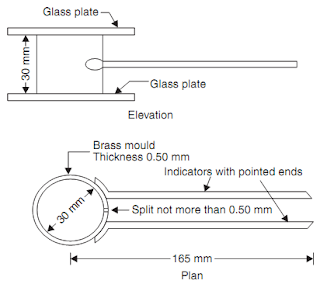- Aim: To find out the Soundness of Cement.
- Apparatus: Le- Ch-atelier’s Apparatus, Weighing balance, measuring cylinder, trowel, mixing pans heater, thermometer.
- Standard Reference: Test is performed as per IS: 4031 (Part – 1) – 1988,
- Theory:
Cement of good quality does not contain the impurities like free lime, magnesia and sulphates, so this should be checked before use.
When it contains the impurities named above, it can expand after reacted with the water, which will result in the unwanted results like, cracking, unwanted expansion of the dimensions and lower strength.
Le-Ch-atelier’s Apparatus is the standard apparatus prescribed as per IS:5514 -1969 to check the presence of the impurities in cement. Cement is said to be sound when the expansion is below 10 mm.
- Procedure:
- Prepare a cement paste of 78% of standard consistency of the cement, and fill it into the split brass cylinder.
- Cover the top and bottom of the cylinder and put it in water at 27 degrees Celsius for 24 hours.
- After 24 hours, measure the separation between the two indicators at their pointed ends.
- Then heat the whole water and immersed cylinder with paste up to a boiling temperature in 30-35 minutes and then boiling for 3 hours.
- After cooling it down, again measure the separation between the two pointers.
- Calculations:
Let the reading before putting the cement paste into the boiling temperature = L1
After three hours of immersion in hot water, reading = L2 then, Expansion = L2-L1
- Result: As the value of expansion is (Less/More)….. than 10 mm so the cement is ………(Sound/Unsound).
Thanks for visit!
Relevant books to buy for competitive exams:
Relevant books to buy for competitive exams:
Please give your reviews and thereby help in improving the article.

